-- From Pine Creek to Borroloola

The road tracklog
from Pine Creek to Borroloola
from 19 to 25/10/2009
The 19/10 on the move towards Katherine I made a detour to see Edith Falls. The spot being pleasant I decided to spend a day there to take stock, to prepare the trip of the future days and to make small do-it-yourself. Actually it was a rest day by 38°C with 10% of moisture in the cell. Fortunately the night the temperature went down to 24°C
Nitmiluk National Park
Edith Falls (Leliyn) are located in the Nitmiluk NP which include famous Katherine Gorges visible either on canoe or on boat or by plane and Cutta Cutta Caves dug in Karst.

Edith Falls
Nitmiluk NP
19/10/2009
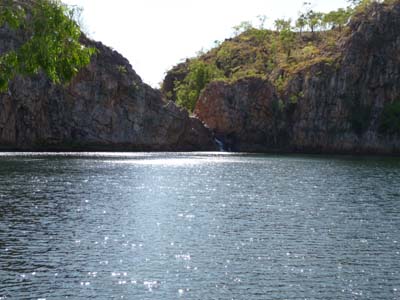
Edith Falls
Nitmiluk NP
19/10/2009
On 20/10, I left without regret Edith Falls
to head to Katherine to do shopping at Woolworths, diesel at Caltex,
to take booklets at Visitor Information Centre, to publish my website and to answer
emails. Arrived around 09:00am I left Katherine about 02:30pm to establish my
bivouac at Katherine Gorges, the campsite was not very welcomed. Moreover the
sky being covered there was no individual candidate for a bird's eye view over Katherine
Gorge by helicopter. Consequently I spent only one night in the
spot.
At ;Woolworths I had the pleasant surprised to see again
Jean Béliveau met in
Dili who continuous his round the world on foot. He walked from Darwin to
Katherine in nine days for approximately 310 kilometres. I greeted his
performance due to extreme heat and ambient dryness. His targets is to reach Alice
Springs then to continue towards the southern coast. We think to see us again
in Daly Waters in one week.
On 21/10 I stayed in Katherine Gorge to prepare the trip to Perth
envisaged at the end of the year.
I have three potential problems to solve:
1-- the control of my truck by MVR before January 11, 2010 in a centre
anywhere.
2-- the expiry date of the carnet de passage en douane on 23/01/2010 which is
required by the MVR!
3-- the change of the four tires of my truck in a few months. Since Darwin I
tried to contact Michelin Australia by emails without success.
Finally in the late afternoon I strolled on the Look Loop Walk to admire Katherine Gorge.

Katherine Gorge
21/10/2009
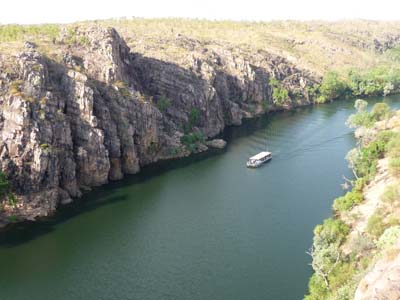
Katherine Gorge
21/10/2009

a bushman
with flynet
Auto portrait
21/10/2009
On 22/10 after Katherine Gorge I returned to the village of Katherine on Stuart Hwy where I went shopping for small equipment and where I sent emails to inform the problems mentioned above. Then on the way I visited the Cutta Cutta Caves with its stalactites and its stalagmites in full desert! The caves are inhabited by a whole fauna, crawling, jumping and birds such as bats.

Cutta Cutta Caves
22/10/2009

Cutta Cutta Caves
22/10/2009
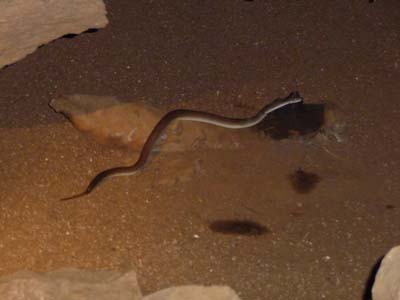
Cutta Cutta Caves
22/10/2009
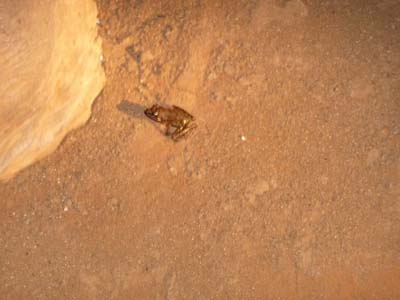
Cutta Cutta Caves
22/10/2009
Jean Béliveau with his "Chariot"
After having lunch I again met Jean Béliveau and his trolley “Chariot” (TM) lunching at the edge of the road at approximately 45 kilometres away from Mataranka. I repeat to him how much I was impressed by his performance; as example his water day consumption was approximately ten litres, it was twelve litres in Mozambique. Later I establish my bivouac in Elsey NP.

Jean Béliveau
22/10/2009

Jean Béliveau
22/10/2009
Savannah Way
Savannah Way heads from Brome on the west coast in the Western Australia to reach Cairns in the north in Queensland. It was a migration path for cattle. For Australians it is an experiment of outback with five World Heritage areas. I traversed during my stay in Australia several sections of this mystical way.
One 22/10 I travelled all the day to join Roper Bar At the entry of one of Savannah Way's tracks. After a junction with Stuart Hwy Roper Hwy became a one-lane road with road side to let road trains, “Give way to road train”. At approximately thirty kilometres away from Roper Bar the road became a Gravel Road but running while having corrugated sheet. Although monotonous landscapes were dramatic. I reached the post around 02:00pm to bivouac one the spot. The place was not very welcomed, however it was necessary to do with. In Roper Bar Store I met an Australian lady who gave me good information on bivouacs and state of track, very difficult. Tomorrow is another day.
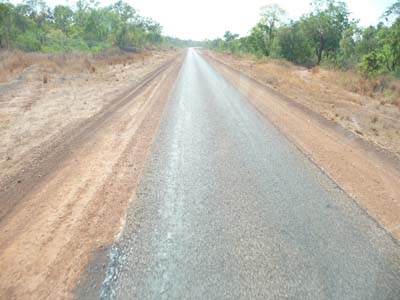
Roper Hwy
23/10/2009

Gravel Road
23/10/2009
At each entrance of aborigine's site billboard recall prohibitions.

Attention
23/10/2009
October 24 I headed on Savannah Way with apprehension. I noted that it was a travelling gravel road with corrugated sections. Bush landscape became very monotonous. Finally in the late morning I achieved my goal Maria Lagoon where I establish the bivouac.
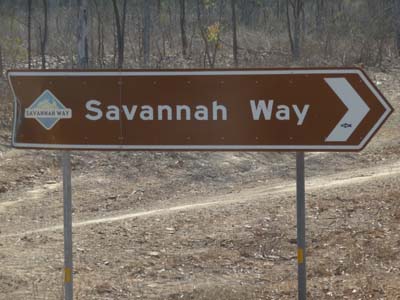
Savannah Way
24/10/2009
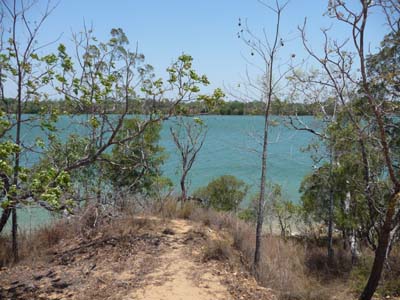
Maria Lagoon
24/10/2009
On Sunday October 25, on the way to Borroloola I visited Southern Lost City. Borroloola was an outpost in the 19th century, without much interest. I establish the bivouac at King Ash Bay for two nights. I carried out the service of my truck and my website. I became acquainted with an Australian couple from Brisbane, the husband repaired my defective electric connection with an ad hoc Australian plug.
Lost City
Australian call “Lost City” intriguing pillars and strange domes out of sandstone eroded by tectonic movements and rains during million years. They are natural habitat of abundant fauna.

Southern Lost City
25/10/2009

Eroded sandstone
Southern Lost City
25/10/2009
The surrounding bush was completely burnt.

Burnt bush
25/10/2009